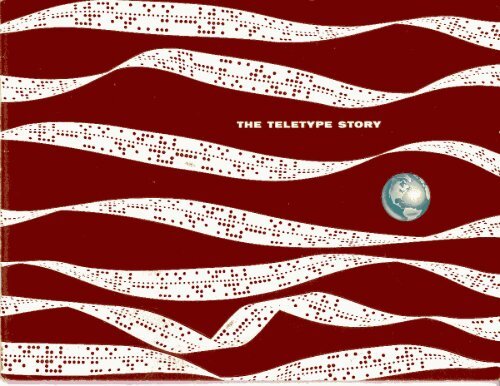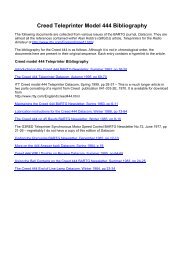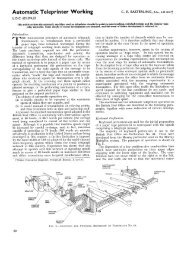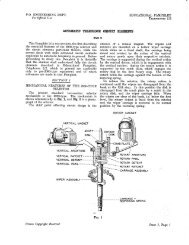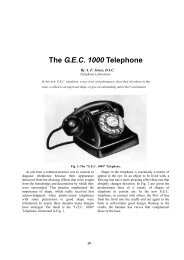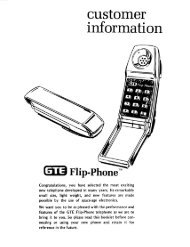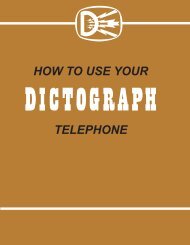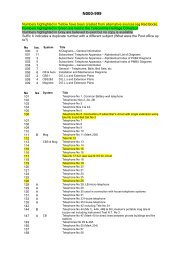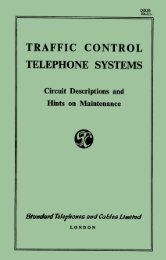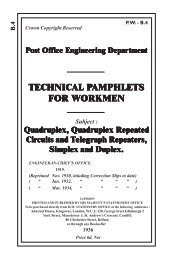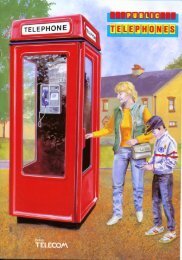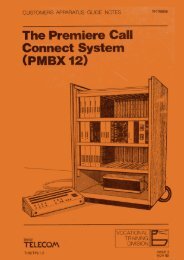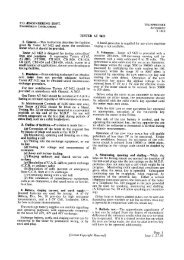You also want an ePaper? Increase the reach of your titles
YUMPU automatically turns print PDFs into web optimized ePapers that Google loves.
<strong>Teletype</strong> Corporation commemorated its<br />
Golden Anniversary in 1957. Fifty years is<br />
a short span in thehistory of<br />
Communication. Yet in that time, <strong>Teletype</strong><br />
has developed its equipment from<br />
primitive models with limited use or<br />
acceptance, to the speedy precision<br />
machines which are an indispensable part<br />
of modern communications. Today<br />
<strong>Teletype</strong> equipment is an important<br />
economic tool, serving in many and varied<br />
ways the demands of our way of life.<br />
This is the story of <strong>Teletype</strong>. It is a story<br />
of challenges met and problems solved,<br />
of faith in the future and of the surpassing<br />
of what were only dreams.
Tom-toms, church bells, smoke signals, the Dead Sea Scrolls,<br />
and the Pony Express – these are all milestones in the endless<br />
effort to bridge time and distance by improving communications.<br />
Until the 19th century the only reliable way to deliver a<br />
message was hand-to-hand or face-to-face. <strong>The</strong> fate of nations<br />
often hung on the arrival of a lathered horse and his spent rider.<br />
A thousand men died at the Battle of New Orleans because news<br />
of a peace treaty signed weeks earlier had not reached the<br />
opposing armies.<br />
It was the harnessing of electricity that almost overnight<br />
catapulted communications into the modern epoch. With the<br />
sending of the first telegraph message by inventor <strong>Sam</strong>uel F.B.<br />
Morse in 1844, both tine and distance were conquered with a<br />
single instrument.<br />
But early telegraphic communication, amazing as it was,<br />
had its drawbacks. Rigorous training was needed for operators to<br />
acquire skill in transmitting and receiving Morse code.<br />
And it took two operators to get a telegram over the wires – the<br />
sender the Morse key to translate the message into dots and<br />
dashes, and another operator at the receiving and to listen for the<br />
code on the Morse sounder and write out the telegram by hand or<br />
on a typewriter.<br />
What telegraphy needed was a system whereby the<br />
messages could be received automatically in the form of<br />
typewritten or “printed” alphabet characters instead of a series of<br />
audible dots and dashes.<br />
An early attempt was the invention of Royal E. House of<br />
Vermont, patented in 1848. it has a piano style keyboard and<br />
used compressed air to actuate the mechanism, which employed a<br />
typewheel and printed on a tape.In 1855 David Hughes<br />
introduced an improved machine built along similar lines. A<br />
significant development occurred in 1874 when a Frenchman,<br />
Emil Baudot, worked out a system of printing telegraphy using a<br />
five-unit selecting code.
<strong>The</strong> story began in 1902 when a young electrical engineer<br />
named Frank Pearne arrived in Chicago with a letter of<br />
introduction to Joy Morton, head of the Morton Salt interests.<br />
Pearne, who had been experimenting with a printing telegraph<br />
system, wanted financial help so he could keep working.<br />
Morton talked it over with his friend Charles L. Krum, a<br />
distinguished mechanical engineer and vice president of the<br />
Western Cold Storage Company, operated by Joy Morton's<br />
brother, Mark. <strong>The</strong> verdict for Pearne was favorable, and a<br />
laboratory was set up for hire in the attic of the cold storage<br />
company.<br />
After about a year of unsuccessful experiments Pearne lost<br />
interest and decided to go into the teaching field. Krum continued<br />
the work and by 1906 had developed a promising model. In that<br />
year his son, Howard, a newly graduated electrical engineer,<br />
plunged into the work alongside his father.<br />
Experiment succeeded experiment, with many moments of<br />
doubt. But, overall, progress was encouraging, and finally the<br />
Morkrum Company -named for Morton and Krum, and later to<br />
be re-named <strong>Teletype</strong> Corporation-was incorporated on October<br />
5, 1907, with a capital of $150,000.<br />
THE FIRST TEST. By 1908 a working model was made<br />
which looked good enough to test on an actual telegraph line.<br />
<strong>The</strong> printing portion was a modified Oliver typewriter, mounted<br />
on a desk with the necessary relays, contacts, magnets, and<br />
interconnecting wires.<br />
Joy Morton, who was a director of the Chicago and Alton<br />
Railroad, arranged for a trial on the railroad's wires between<br />
Chicago and Bloomington, a span of about 150 miles. <strong>The</strong> test of<br />
the experimental printer was highly promising and Charles and<br />
Howard Krum went back to work, making more models and<br />
improving them, seeking to develop a small neat, direct keyboard<br />
typewheel printer.<br />
This was a period of basic invention and experimentation<br />
with printing telegraph. Western handling part of its traffic with<br />
the Barclay system; the Hughes and Baudot systems were being<br />
used abroad, and there were many others.<br />
Each system had advantages, disadvantages, imperfections.<br />
In general. they were apt to be extremely delicate, overly<br />
complicated, and too expensive in manufacturing cost and<br />
maintenance to be practical. <strong>The</strong> most serious problem was<br />
maintaining synchronism between the sending machine and the<br />
remote printer. If the distant unit was “off;” it would receive the<br />
signals in improper sequence and print gibberish. For reliable<br />
transmission, the sending and receiving units had to be “in step”<br />
with each other-and the synchronism had to be maintained<br />
throughout transmission.<br />
It remained for this problem to be solved before the printing<br />
telegraph concept could take giant steps in the communication<br />
world.
Among Howard Krum's many contributions to printing<br />
telegraphy, one of the most significant was his solution for the<br />
problem of synchronizing sending and receiving units.<br />
A brief look at how <strong>Teletype</strong> equipment works is helpful in<br />
understanding his accomplishment.<br />
<strong>Teletype</strong> machines operate by the transmission of electrical<br />
“pulses” over wires from a sending unit to a receiving unit. <strong>The</strong><br />
sending unit creates the pulses by mechanical action following<br />
the pressing of typewriter-like keys. <strong>The</strong> receiving unit converts<br />
the pulses back into mechanical action, producing typed letters or<br />
figures. <strong>The</strong> electrical “pulse” can best be described as a brief<br />
electric flash, or flow of current, stopped or started at will. <strong>The</strong><br />
illustration on this page graphically explains this action.<br />
With the Morse telegraph, the operator who receives listens<br />
to a series of unequal dot-dashes which constitute a code, and<br />
theft translates them into the written word. <strong>Teletype</strong> machines<br />
“listen” to a code in which each letter or number is made by a<br />
combination of electrical pulses of equal length and<br />
automatically translate this code into printing. But the receiving<br />
machine must be “listening” in unison with the sending machine.<br />
Howard Krum's idea for keeping sending and receiving<br />
machines together was to add a “start” pulse before each code<br />
combination, and a “stop” pulse after each code combination.<br />
This provided a fresh start and a “correction” period for each<br />
character and made it comparatively simple to keep the sending<br />
and receiving machines in step for the fraction of a second<br />
required to transmit a character code combination. Thus full<br />
synchronization was achieved.
FIRST SALE. A significant milestone in the young<br />
company's life-its first commercial sale-occurred in 1910. In<br />
that year the Postal Telegraph System - since merged with<br />
the Western Union but then the second largest telegraph<br />
company in the country - authorized Morkrum to make an<br />
installation on its lines between New York and Boston.<br />
Postal Telegraph had been concerned as to whether the<br />
Morkrum system would function on ordinary telegraph lines<br />
in good and bad weather. <strong>The</strong> installation proved most<br />
successful. Two years later Postal had eight Morkrum<br />
circuits, averaging 300 miles in length, the longest being the<br />
1,000 mile New York to Chicago line.<br />
In 1912 Western Union became a customer, and by the<br />
middle of that year had six circuits in operation. Equipment<br />
was so improved by this time that there is a record of 1,207<br />
messages exchanged in one nine-hour day, and an instance<br />
of an operator sending 104 messages in one hour between<br />
Boston and New York.<br />
About this time the Chicago, Burlington & Quincy<br />
installed Morkrum printers between Chicago and Galesburg,<br />
Illinois. This was soon followed by installations for the Rock<br />
Island, New York Central, Lake Shore, B. & O., and the<br />
Canadian Pacific.
<strong>The</strong> outbreak of World War I and subsequent entry of the<br />
United States led to a shortage of skilled Morse telegraphers<br />
for civilian needs.<br />
<strong>The</strong> result was to focus attention on printing telegraphy.<br />
A trade journal of those days remarked, "With this system it<br />
is not necessary for the operator to understand the Morse<br />
code, as anyone who can operate a typewriter keyboard can<br />
do the work. <strong>The</strong> system also greatly increases the capacity<br />
of the telegraph lines'.'<br />
During this period the Pennsylvania Railroad undertook<br />
an extensive program of replacing Morse circuits with Morkrum<br />
equipment. <strong>The</strong> Union Pacific also installed equipment,<br />
followed by others, and commercial telegraph and press<br />
circuits were extended.<br />
An unusual application for those times was the setup<br />
developed in 1917 for Carson Pirie Scott & Company, one of<br />
Chicago's great department stores, linking its warehouse and<br />
wholesale departments. <strong>The</strong> system immediately proved to<br />
be a great time saver.<br />
That year, Sterling Morton became active in the company,<br />
assuming the presidency and directing sales.<br />
By 1918 the young company had grown to the point<br />
where it could think of a plant of its own in place of rented<br />
quarters. A survey showed that a majority of the 200 employees<br />
by then on the rolls would be best served by a location<br />
on the north side of Chicago. Accordingly a site was<br />
selected on Wrightwood and Southport Avenues, and a<br />
building with an area of 35,000 square feet was constructed.<br />
<strong>The</strong> first payroll in the company's new home was figured out<br />
on Thanksgiving Day.<br />
About this time, also, the company embarked on a diversification<br />
program to fill the gaps between orders for<br />
printing telegraph machines. Various items were manufactured,<br />
in cluding penny pencil sharpeners, wire braid removers,<br />
an air gauge for tires, a patented lock for automobiles<br />
with an “unpickable” combination, and a check handling<br />
machine marketed under the name of the “National Check<br />
Endorser:”<br />
To make even better headway financially, a change was<br />
also made in the method of marketing Morkrum equipment.<br />
Up to this time most of the Morkrum machines in the field<br />
were being leased to customers on a monthly rental basis.<br />
This policy was now abandoned in favor of outright sale.
Research and development, always the lifeblood of the business,<br />
proceeded at a swift pace. <strong>The</strong> Model 11, a compact machine<br />
operating at 40 words per minute and using a typewheel to print<br />
on paper tape (somewhat like a stock ticker) was introduced for<br />
light duty service. It was to this machine, incidentally, that the<br />
name “<strong>Teletype</strong>” was first applied, and it was in the company's<br />
sales literature on this unit that the <strong>Teletype</strong> scroll symbol, selected<br />
through an employee contest, was first used. <strong>The</strong> year was<br />
1921.<br />
One of the earliest installations of the Model 11 was in the<br />
Congress Hotel in Chicago in 1922, permitting registration,<br />
departure, billing, and other information to be transmitted simultaneously<br />
to various departments in the hotel.<br />
Next to come along was the Model 12. This page printer<br />
with typebars like a typewriter, was the first Morkrum machine<br />
to be used extensively by general business firms, in private wire<br />
service. It was also quickly adopted by the press associations, and<br />
for many years “delivered” practically all the press wire news in<br />
the United States and Canada. Its construction was so rugged that<br />
the first installation - a network of 37 printers put in for the<br />
Chicago Police Department in 1922 - did not require replacement<br />
until 1956. In all, 12,000 Model 12's were sold, two as recently<br />
as 1943<br />
About this time Morkrum began to experiment with radio<br />
transmission of printing telegraph signals, a pioneering effort<br />
which was to pay huge dividends in World War II.<br />
Printed messages were sent by “wireless” in 1923 from the<br />
transmitting tower at the Wrightwood Avenue plant to the home<br />
of Sterling Morton in Lisle, Illinois, some 30 miles away. That<br />
same year test messages were sent from Chicago to Milwaukee,<br />
Wisconsin and Lafayette, Indiana.<br />
In 1924, the telegraph companies began to turn their attention<br />
to the use of printers on their tributary circuits, as well as the<br />
pick-up and delivery wires between their main office and branch<br />
and customers' offices. For this service they wanted a heavy-duty<br />
tape printer. With tape printers it is not necessary to return a<br />
carriage or start a new line. Telegraph line time is conserved and<br />
the machines themselves are simpler and less expensive.<br />
Morkrum thereupon developed the Model 14, a typebar tape<br />
printer so simple and sturdy it could be installed in the most<br />
remote telegraph office with only rare visits from the maintenance<br />
man. This machine, introduced in 1925, was the first<br />
printer to be almost wholly mechanical. Messages were (and in<br />
many telegraph offices still are) printed on gummed 3/8" paper<br />
tape, which the operator pasted onto the familiar telegraph<br />
blanks.<br />
MERGER - AND A NEW NAME - During these years of the<br />
Morkrum Company's growth and development the Kleinschmidt<br />
Electric Company, formed by inventor Edward K. Kleinschmidt<br />
in New York, was also manufacturing printing telegraph instruments<br />
and serving some of the same customers, particularly the<br />
telegraph companies.
In 1924 a patent conflict developed between the two firms. This<br />
led to a meeting between Sterling Morton and Charles B.<br />
Goodspeed, who was associated with Kleinschmidt Electric. Out<br />
of their session came a six-line memorandum which became the<br />
basis for a merger creating the Morkrum-Kleinschmidt Corporation,<br />
with Sterling Morton as president and Edward Kleinschmidt<br />
and Howard Krum as vice presidents. <strong>The</strong> Wrightwood plant was<br />
enlarged, and the new company embarked on a period of phenomenal<br />
growth.<br />
1925 saw the establishment of the company's Development<br />
& Research Department, complete with its own model<br />
shop and testing laboratories. It was soon engaged in a variety<br />
of new projects, including an improved page printer, a<br />
fire alarm system, a method of setting type by wire in newspaper<br />
and printing plants, and a transmission system for<br />
automatic stock quotation display boards.<br />
<strong>The</strong> <strong>Teletype</strong> School of Maintenance Training was also<br />
established during this period. <strong>The</strong> school offers tuition-free<br />
classes of several weeks' duration in which customers enroll<br />
their personnel for instruction in the operating theory, adjustments,<br />
and maintenance of the various <strong>Teletype</strong> apparatus<br />
units. Classes are held on a regular schedule throughout<br />
the year.<br />
As the '20s drew to a close, trading on the New York<br />
Stock Exchange became so heavy that the old stock tickers,<br />
running at about 200 characters a minute, were unable to<br />
keep up with the volume. <strong>Teletype</strong> developed a high speed<br />
stock ticker, operating at 500 characters a minute. One of the<br />
interesting features of this machine is that it employs a sixunit<br />
code for the purpose of saving the operators at the Exchange<br />
transmission headquarters the time required for<br />
operating the shift keys. <strong>The</strong> sixth pulse was added to characters<br />
in the “Figures” position and acts as an automatic<br />
shift.<br />
<strong>The</strong> ticker was introduced in 1928, and was soon placed<br />
in service in the offices of hundreds of their clients in the<br />
United States and Canada by Western Union and the New<br />
York Quotation Company.<br />
In December, 1928, the company’s name was changed<br />
for the sake of simplicity from Morkrum-Kleinschmidt<br />
Corporation to <strong>Teletype</strong> Corporation. Thus its equipment<br />
trademark also became its corporate name.<br />
By the end of 1929 Wrightwood headquarters covered<br />
280,000 square feet of floor space in twelve buildings, eight<br />
times the space occupied just five years before, and employment<br />
had risen to 2,400. Production figures revealed that<br />
a revolution had taken place in communications. From 1918<br />
to 1927, 15,500 <strong>Teletype</strong> instruments were made. In 1928<br />
alone, 12,700 instruments were produced, and 1929 production<br />
reached 25,200 for the one year. And these instruments<br />
were in service not only in the United States and Canada but<br />
also in many countries abroad.
1930 marks another important milestone in the company's<br />
history. In that year, the <strong>Teletype</strong> Corporation was purchased<br />
by the American Telephone and Telegraph Company and<br />
became a subsidiary of the Western Electric Company.<br />
Sterling Morton, who had been president of the company<br />
since 1917, retired from the scene, as did Edward Kleinschmidt,<br />
who had been a vice president since the merger in<br />
1924. Howard Krum stayed on for some years as a consultant,<br />
guiding the company's development and research program.<br />
For some years prior to its acquisition of <strong>Teletype</strong>,<br />
Western Electric had itself been a manufacturer of teletypewriter<br />
equipment, making apparatus of its own design.<br />
Gradually, however, the company withdrew from the field<br />
and <strong>Teletype</strong>, as a specialist, supplied more and more of the<br />
equipment needed by the Bell System for private wire service<br />
to business firms.<br />
While the Bell System used the Model 12, they indicated<br />
a desire for additional features that would be an advantage<br />
in private wire service. <strong>The</strong> Model 15, placed in volume<br />
production in 1930, incorporated these features and many<br />
others.<br />
This became the standard <strong>Teletype</strong> page printer that was to<br />
see service all over the world.<br />
Quieter in operation than the Model 12, it was also less<br />
bulky. Of major importance was the fact that the paper<br />
platen which on the Model 12 moved as the message was<br />
typed-remained stationary while the type basket moved<br />
across the paper, eliminating paper feeding problems.<br />
<strong>The</strong> machine also offered a broader scope for extra features,<br />
such as control of associated equipment, tabulating<br />
mechanisms, and handling of business forms. In design, it<br />
was as nearly as possible a page version of the Model 14<br />
tape printer, with all that unit’s mechanical simplicity, sturdiness.<br />
and extreme reliability for unattended services.<br />
With the Model 15 printer available. the Bell System inaugurated<br />
TWX - teletypewriter Exchange Service - in 1931.<br />
Subscribers were able to type by wire to each other, through<br />
a switchboard connecting system, just as they could talk to<br />
each other by telephone. <strong>The</strong> big advantage was that a written<br />
record of the message was available at both ends. In its<br />
first year an average of only 50 TWX messages were sent<br />
daily. Now approximately 40,000 teletypewriters send
almost 100,000 messages over a huge nationwide network<br />
every day.<br />
In 1932 <strong>Teletype</strong>setter equipment was introduced to the<br />
newspaper and printing fields. This is essentially a combination<br />
of teleprinting and machine typesetting. Using paper<br />
tape perforated in six-level code, the “TTS,” as it has come<br />
to be called, replaces manual operation of linecasting machines<br />
with automatic operation at high speeds, producing<br />
double or more the output normally obtained by manual<br />
methods.<br />
When used with its associated <strong>Teletype</strong> equipment, TTS<br />
can also set type at many distant points simultaneously. Thus<br />
it is used by newspapers not only for local copy but to speed<br />
press association stories directly into type, and by large<br />
weekly magazines and financial dailies which must be<br />
printed in several plants simultaneously. It has also found<br />
many interesting uses in specialty printing, such as directories<br />
and greeting card imprints.<br />
Another development which reached maturity during<br />
the '30s was that of message relaying. In extensive network,<br />
with a large number of machines, it is neither economical<br />
nor practical to set up wire lines so every printer can contact<br />
every other printer in the network directly. Instead, relay<br />
points or message centers are established which accept traffic
from the surrounding areas and send it along to its destination<br />
or the next relay point.<br />
In early days such relaying was handled by redoing the<br />
messages on a printer or perforator keyboard. This was<br />
plainly a duplication of effort. In 1925 Morkrum made an<br />
early form of “reperforator” or receiving perforator for the<br />
Associated Press. This provided the relay points with the<br />
press stories in punched tape, and they could be sent along<br />
by simply feeding the tape into a transmitter-distributor.<br />
A production reperforator was introduced in 1928. Principal<br />
users were the railroads, the Bell System, and, afterwards,<br />
the military.<br />
Later a unit was developed which combined a reperforator<br />
with a typing mechanism-the famous “typing reperforator”<br />
-which eliminated the need for the attendants at the relay<br />
points to know the Baudot code. <strong>The</strong> unit was first used in a<br />
system installed by the Postal Telegraph-Cable Company in<br />
1940. It was in this system also that. multiple-mounted<br />
transmitter distributors and message numbering transmitter<br />
distributors were first used, all of the equipment being<br />
grouped in cabinets.<br />
This came to be known as the “torn-tape” method of<br />
message relaying, because the attendant severed each message<br />
as it came in simply by tearing it, after which it was fed<br />
into the transmitter by hand. It is still the simplest and most<br />
flexible method of relaying and is in wide use today. Another<br />
method of relaying, called “push button” or “semiautomatic”<br />
was developed later by the Western Union Telegraph<br />
Company. Here the attendant reroutes the message by<br />
reading the address on the tape, then pushing a button to<br />
switch in the appropriate transmitter-distributor.<br />
As industry expanded following its recovery from the<br />
depression of the early thirties, establishing a pattern of<br />
widely scattered branch plants, many companies turned to<br />
<strong>Teletype</strong> equipment as an efficient means of centralizing<br />
operations and communications. Two of the private wire<br />
networks engineered just prior to World-War II, for General<br />
Electric and Republic Steel, were milestones in the printing<br />
telegraph art. <strong>The</strong>y were equipped with the first fully automatic<br />
switching systems, developed by the Bell Telephone<br />
Laboratories, with <strong>Teletype</strong> designing special printing telegraph<br />
components and cabinetry.<br />
<strong>The</strong> automatic: equipment at the communication center<br />
does an almost miraculous job. It “reads” the address code<br />
on the incoming message and directs it to the proper destination<br />
or to several destinations simultaneously. If the line<br />
should be busy, it can store the message temporarily for<br />
transmission later. It also controls the starting and stopping<br />
of machines at outlying points, and acts as a “traffic cop” to<br />
level out message flow.
When World War II started, armies needed words with<br />
wings. Quick, accurate communication-with a written record<br />
available-was vital to the movement of millions of men and<br />
women, vast quantities of munitions, hundreds of thousands<br />
of vehicles and supply items, and thousands of planes to and<br />
from every corner of the world.<br />
<strong>Teletype</strong>, like other firms, was to know some unfamiliar<br />
assignments, such as the manufacture of component parts for<br />
gun directors. But its real war task was to manufacture its<br />
own communications equipment-and to produce that equipment<br />
in the greatest possible quantities and the shortest<br />
possible time. <strong>The</strong> Wrightwood plant went to three shifts,<br />
additional space was leased, thousands of new employees<br />
were hired. Subcontractors by the dozen were called upon<br />
for help, “expediter” and “coordinator” became familiar<br />
words.<br />
For the lines of command reached everywhere-from<br />
Washington, from London, from Australia, from Pearl Harbor,<br />
from field headquarters, and from flagships at sea.<br />
Wherever men and women were involved in the struggle<br />
because rapid and accurate communication often meant the<br />
difference between victory and defeat there also were <strong>Teletype</strong><br />
machines.<br />
Circuits were developed into systems and systems into<br />
world-girdling networks that stretched from igloos to South<br />
Sea jungles, from offices in the Pentagon to command posts<br />
in German castles.<br />
In the field the teletypewriter moved with the arms. On<br />
the sea, it moved with ships. Maintenance and shipping<br />
difficulties caused by differing climates, transportation, and<br />
rough handling, were met and overcome.<br />
<strong>The</strong> variety of installations was almost infinite. Masses<br />
of messages were carried between principal centers in this<br />
country, and then fanned out to ultimate destinations.
Tactical circuits were in constant use for ordering equipment,<br />
troops, and planes into immediate action.<br />
Control of the flow of supplies and personnel, coordination<br />
of production and the vital administrative message<br />
traffic required more and more <strong>Teletype</strong> equipment at home.<br />
Overseas, command circuits connected principal headquarters<br />
with air fields, with troop centers, and with warships.<br />
<strong>The</strong> pace at <strong>Teletype</strong> quickened to meet the challenge<br />
and production soared until in 1944 it was 15 tithes what it<br />
was in 1939. That year the men and women of <strong>Teletype</strong><br />
received the Army-Navy “E” award for their production<br />
record.<br />
Novel special applications were developed during the<br />
war. By modifying a page printer and connecting it with an<br />
optical projector, visual briefing material was flashed aboard<br />
carriers from a central point to pilots’ ready rooms. An adaptation<br />
of this idea created a new word - and a new idea - teleconferences<br />
between groups widely separated.<br />
One use of <strong>Teletype</strong> equipment which caught the imagination<br />
of the world was for personal “conversations” between<br />
President Roosevelt and Prime Minister Churchill. A<br />
secret device scrambled the messages beyond the possibility<br />
of their being decoded if intercepted by the enemy.<br />
On June 6, 1944 there was sent one of the most dramatic<br />
<strong>Teletype</strong> messages ever transmitted. In newspaper offices<br />
and radio stations throughout the country the “stand by”<br />
warning was typed out. A few minutes later came the signal<br />
for news that would change the course of the war - then<br />
FLASH! “Eisenhower Headquarters Announces Allies Land<br />
in France.”<br />
For <strong>Teletype</strong> perhaps one of the most important results<br />
of the wartime use of its equipment was that millions of<br />
people from all walks of life personally discovered this<br />
efficient communication medium for the first time while in<br />
service. This created a powerful impetus for its expansion<br />
into peace-time uses. In addition, numerous installations<br />
overseas, many of which became war surplus, were purchased<br />
by foreign governments and organisations.
With the coming of peace, <strong>Teletype</strong> returned to its civilian<br />
role, and was soon hard at work to meet the backlog of demand<br />
built up during the long years when all effort was<br />
devoted to winning the war. To this backlog were now added<br />
the demands of a rapidly expanding economy. <strong>Teletype</strong><br />
equipment came into ever wider use to solve new communications<br />
problems resulting from distance, complexity, faster<br />
pace, and heavier volume of business.<br />
Military communication needs also continued substantial,<br />
with American troops more scattered than they had ever<br />
been before, on practically every continent. When the Korean<br />
conflict broke out, large quantities of <strong>Teletype</strong> equipment<br />
were required. A continuous development program to<br />
meet defense needs resulted in the introduction of such<br />
equipment as the electronic multiplex (for sending several<br />
messages simultaneously over a single channel), a torn-tape<br />
relaying system packaged and powered for easy transfer<br />
from one location to another, and a 600 speed tape transmission<br />
system.<br />
RAILROADS - By this time <strong>Teletype</strong> equipment was<br />
in service for railroads in a great number of ways. It streamlined<br />
and speeded up the handling of perishable freight, car<br />
tracings, passenger reservations, train departures and arrivals,<br />
and switching operations in freight classification yards.<br />
To these were now added new techniques, such as “tape to<br />
card and card to tape,” enabling the railroads to simplify and<br />
expedite the preparation and handling of train consists and<br />
manifests, and yielding important savings in their accounting<br />
procedures.<br />
CAA WEATHER REPORTS - Shortly after the end<br />
of World War II an interesting project was undertaken for<br />
the Civil Aeronautics Administration, whose 600 weathermen<br />
in locations from Alaska to Florida send in hourly<br />
reports over a <strong>Teletype</strong> equipment network, going through<br />
regional relaying points and distributed throughout the system.<br />
<strong>The</strong> problem was to place the pickup of data from the<br />
outlying weathermen on an automatic basis, to utilize the<br />
wire lines at full efficiency as well as eliminate the time the<br />
men spent waiting their turn to send reports.<br />
<strong>Teletype</strong> developed a device known as the Sequential<br />
Control (SECO) so each man could punch his report in a<br />
tape, put the tape in a transmitter, and go about other work.<br />
<strong>The</strong> SECO at the regional receiving center automatically<br />
turns the transmitters on in proper rotation, picking up the<br />
taped messages. If the report from a station is not ready,<br />
SECO waits three seconds, then calls in the next station.
THE RED CROSS - <strong>The</strong> American Red Cross has<br />
long operated a nation-wide leased wire <strong>Teletype</strong> installation<br />
tied in with overseas points to provide a world-wide emergency<br />
message center for members of the Armed Forces.<br />
<strong>The</strong> system is used in disasters when normal communications<br />
are disrupted. In these cases, mobile Red Cross units<br />
equipped with radio <strong>Teletype</strong> apparatus fill in until commercial<br />
service is restored. In a major disaster, these mobile<br />
units may handle more than 5,000 messages a day. Over-all,<br />
the “Amcross” system has grown until it now handles more<br />
than sixty million words a year.<br />
When Hungarian refugees were flown into Cramp Kilmer<br />
in 1956, the Amcross network was used to convey messages<br />
to friends and relatives throughout the United States. A<br />
special line was leased from Washington, D. C., to Toronto,<br />
Canada, to speed communications with the Canadian Red<br />
Cross.
OIL FLOW REGULATION - An interesting use involves<br />
the reguation of the flow of oil through pipe lines. Linked by<br />
a teletype network, a central control point automatically<br />
receives information from a number of locations, known as<br />
booster stations, as to oil flow. <strong>The</strong>se stations are spotted<br />
long a pipeline which may be thousands of miles long. information<br />
received at the control point is the basis of regulation<br />
of flow through the line, either from wells or “tank<br />
farms” to meet refinery requirements.<br />
THE DEW LINE - Standing guard in far Northern Canada,<br />
the Distant Early Warning Line is a vital element in our<br />
defense against air attack. <strong>Teletype</strong> equipment plays an<br />
important part in its communication system. Similarly, Continental<br />
Air Defense Command, charged with initial active<br />
air defense based largely on DEW Line information, is<br />
linked by <strong>Teletype</strong> communication.<br />
NATIONAL POLICE NETWORK - One of the most interesting<br />
and important <strong>Teletype</strong> equipment networks in operation<br />
today is the coast-to-coast state police system-a great<br />
advance from the first localized police system, installed in<br />
Chicago in 1922.<br />
<strong>The</strong> National Police <strong>Teletype</strong>writer Network, which began<br />
operations in 1956, links 43 states and the District of<br />
Columbia. <strong>The</strong> communication network of each individual<br />
state is linked to the national network through a central<br />
location in the state, from which messages can be flashed to<br />
similar central points in other states.<br />
<strong>The</strong> system provides accurate and instantaneous printed<br />
communications, minimizing confusion and errors, and<br />
furnishing “documentary evidence” in flashing such items as<br />
warrant requests thus greatly facilitating the handling of<br />
jurisdictional problems.
FINANCIAL USE - Nowadays it is commonplace for stock<br />
exchange member firms to depend heavily upon <strong>Teletype</strong><br />
equipment, not only for quotation service, but also as a vital<br />
link in their large and exacting communication requirements.<br />
In a typical case, the order of a branch office customer<br />
for the purchase or sale of securities will be teleprinted<br />
directly from the distant office to the New York Stock Exchange<br />
floor. <strong>The</strong> order is filled and confirmation teleprinted<br />
back to the originating office - all in a minute or two. With<br />
the confirmation, a copy is sent simultaneously to the accounting<br />
department, saving much clerical effort.<br />
In another typical case, billing machines in branch offices<br />
go to work after the market closes, automatically typing<br />
out confirmations of each trade made that day by local customers.<br />
<strong>The</strong> data for these trades are computed on business<br />
machines in New York, translated onto teleprinter tape, and<br />
wired to each office.<br />
THE AUTOMOBILE INDUSTRY - Automobile<br />
manufacturers were early users of 'teletype equipment. Today<br />
they not only have large private wire networks for their<br />
internal communications needs, but also use <strong>Teletype</strong><br />
equipment in specialized ways. For example, the modern<br />
automobile assembly line handles a succession of body<br />
styles, colors, and optional equipment in astonishing variety,<br />
made up to the orders of individual
customers. A <strong>Teletype</strong> equipment network is used in scheduling<br />
the hundreds of assembly components and special<br />
accessories, to insure the flow of material to assembly points<br />
in proper sequence.<br />
INTERNATIONAL EXCHANGE - TEX, the Radio<br />
Corporation of America's Teleprinter Exchange Service,<br />
provides two-way international communications to subscribers<br />
in more than 30 countries. American Cable and Radio<br />
System offers International Telex, a similar service, reaching<br />
thirteen countries from the United States and Canada. Both<br />
services are available to TWX subscribers, thus forming a<br />
world-wide system for person-to-person interchange of the<br />
written word.<br />
Leased Channel Service, the radio equivalent of leased<br />
private wire service, provides channels to international airlines,<br />
industrial organizations, stock and commodity brokers,<br />
and departments of the government for their own exclusive<br />
use.<br />
AMATEUR RADIO - Thousands of radio "hams" now<br />
transmit via <strong>Teletype</strong> equipment. In addition to providing an<br />
absorb, ing hobby for an increasing number of men and<br />
women, ham radio constitutes a communication reserve for<br />
emergencies, often being of invaluable aid where other<br />
means of communication are not available. Ham radio is also<br />
important in civil defense.
NEW PLANT FACILITIES - Meeting the heavy postwar<br />
demand for <strong>Teletype</strong> equipment has necessitated a<br />
steady program of enlarging facilities. In 1950 <strong>Teletype</strong><br />
acquired a manufacturing plant with 115,000 sq. ft. of floor<br />
area at 5701 Touhy Avenue, Niles, Illinois, just northwest of<br />
Chicago. In 1954 a large plant, with 376,000 sq. ft., was<br />
purchased at 4100 Fullerton Avenue, in Chicago; this location<br />
is used partly for office space to accommodate sales and<br />
merchandising activities, and partly for assembling and<br />
shipping.<br />
In 1956 <strong>Teletype</strong> acquired a manufacturing plant with<br />
52,000 sq. ft. adjacent to the original Touhy structure. In<br />
addition 236,000 sq. ft. were leased in four Chicago locations,<br />
and considerable manufacture was subcontracted. New<br />
and greatly enlarged quarters were also leased for the <strong>Teletype</strong><br />
School of Maintenance Training, at 201 N. Wells Street,<br />
Chicago.<br />
With a view to the future, <strong>Teletype</strong> early in 1957 purchased<br />
a tract of land at the Touhy location on which three<br />
buildings are to be erected - a manufacturing unit. an administration<br />
building, and a development and research center.<br />
Construction of the manufacturing unit, with 500,000 sq.<br />
ft., was begun immediately. Eventually the Touhy location<br />
will replace Wrightwood as <strong>Teletype</strong> Corporation’s headquarters.<br />
To obtain the advantages of a second geographical location,<br />
a 160 acre site was acquired in Little Rock, Arkansas,<br />
in the spring of 1957. Pilot operations in leased quarters are<br />
already under way. Later a 400,000 sq. ft. building is<br />
planned. <strong>The</strong> Little Rock location will be a completely<br />
autonomous manufacturing unit, from the purchase of raw<br />
material through machining, assembly, and merchandising.
Invention, research, development..... these have always been<br />
stressed at <strong>Teletype</strong>. Thus the company undertook the development<br />
of an entirely new line of equipment - the Model 28.<br />
<strong>The</strong> apparatus was to be like nothing ever seen in the printing<br />
telegraph field.<br />
It was to run at 100 words per minute with less maintenance<br />
than required by conventional equipment at 60 words<br />
per minute - and at the same time it must be quieter in operation<br />
and lighter in weight. It was to have provision for incorporating<br />
extra features and remote controls on a scale hitherto<br />
undreamed of. It must take in its stride environmental<br />
handicaps such as arctic cold and tropical heat, as well as the<br />
shock, vibration, and non-level positions inherent in operating<br />
aboard moving vehicles.<br />
Finally, it was to be designed on the “building block”<br />
principle, to permit maximum interchange of parts, mechanisms,<br />
and units. Thus it would combine the benefits of<br />
manufacture by quantity production methods with a broad<br />
scope for meeting the often highly specialized requirements<br />
of the individual user.<br />
This “blue print” was actually conceived prior to World<br />
War II, but work began in earnest at war’s end. Naturally,<br />
many problems were encountered in designing a printer to so<br />
demanding a set of performance specifications, but one by<br />
one these were solved. After a succession of models, laboratory<br />
tests, and extensive field trials, the first lot of the new<br />
Model 28 page printers was ready late in 1950. Urgent needs<br />
of the Armed Forces in the Korean crisis were given priority,<br />
and it was not until 1953 that the machine was available to<br />
the general public.<br />
In looking at the new printer, perhaps the most striking<br />
feature is the replacement of the usual bulky type-basket<br />
with a miniature carriage consisting of a 1” x 3” type-box<br />
and a tiny print hammer. Internally, there are other innovations.<br />
<strong>The</strong> machine has no structural castings; side frames<br />
and base plate are resilient sheet metal. Speed and quiet<br />
operation are built in, not only with light-weight parts but<br />
with the principle of harmonic motions - so that the machine<br />
runs more smoothly and easily at 100 words per minute than<br />
conventional designs at slower speeds. Clutches are all-metal<br />
and call for oiling once or twice a year, in contrast to two<br />
weeks for felt clutches.<br />
Of exceptional interest is the provision for extra features<br />
and remote controls. This is handled through a mechanism<br />
called the “stunt box” (“stunt” being an old printing telegraph<br />
designation for non-typing functions). In effect a builtin<br />
sequential selector, this 9¼” ," x 4½” unit has slots which<br />
can be equipped with trains of miniature parts or switches to<br />
perform an almost unlimited array of tasks.<br />
<strong>The</strong> “building block” principle can best be illustrated in<br />
the new composite set, the Model 28-ASR, introduced in<br />
1957. Innumerable variations are possible in the basic combination<br />
of send-receive page printer, tape punch, and tape<br />
reader to fit the requirements of the individual user.<br />
Thus the Model 28 line is more versatile and more<br />
flexible than any printing telegraph equipment hitherto<br />
made. It is geared for today’s increasingly complex needs,<br />
with built-in provision for new demands which tomorrow is<br />
certain to bring.
What of the future? Throughout its history, <strong>Teletype</strong> has<br />
constantly widened communications horizons. Today the<br />
possibilities and variations for new applications of <strong>Teletype</strong><br />
equipment appear to be almost limitless. A period is now<br />
developing which future historians may compare to the onset<br />
of the Industrial Revolution, and such periods inevitably<br />
bring changes in accustomed practices.<br />
RECORD AND DATA PROCESSING - <strong>The</strong> field of<br />
office work, record keeping, and data processing is one in<br />
which change is already beginning to take place on a sizeable<br />
scale. <strong>The</strong>re are a number of reasons for this.<br />
In the first place, there is the development of the complex<br />
and vastly ingenious computing machines which can<br />
accomplish in a few seconds data processing operations that<br />
would otherwise require thousands of skilled man hours.<br />
Second, many organizations are expanding to the point<br />
where time, cost, and control considerations make rapid<br />
processing of record data absolutely vital. Finally, there is<br />
the sheer mass of paperwork in which we are all engulfed,<br />
with the ratio of paper-handling effort to production effort<br />
rising steadily.<br />
Thus we find change entering the office under such<br />
names as automation, automated data processing, electronic<br />
data processing, and integrated data processing. Of these, the<br />
last, usually referred to as “IDP,” is probably best known.<br />
<strong>The</strong> general objectives of these various systems are (a) to<br />
eliminate duplication of typing effort by providing for automatic<br />
reproduction of repetitively used information (as in<br />
order, invoice, shipping label, and inventory entry); (b) to<br />
transmit the required portions of the information quickly and<br />
simultaneously to all departments and locations involved; (c)<br />
to provide up-to-the-minute records in all areas of the business<br />
for the guidance of management.<br />
<strong>Teletype</strong> equipment enters into such systems not only as<br />
a communication instrument to transmit information instantaneously<br />
wherever it is needed, but also to provide and
eproduce punched tape and to type on forms. Much of this<br />
is on a “by-product” basis.<br />
<strong>The</strong> office revolution is leading to a further trend, that<br />
of geographically centralized accounting systems for large<br />
organizations. Here, computers handle the heavy paperwork<br />
jobs such as payrolls, statements, dividend payments, and<br />
freight car accounting, with <strong>Teletype</strong> communication networks<br />
to carry information to and from the outlying points.<br />
It is likely that in the future small businesses will enjoy<br />
similar advantages through independent computer services,<br />
or perhaps by banding together cooperatively or through<br />
their trade associations- with private wire or TWX networks<br />
providing a swift highway for the data.<br />
FACTORY AUTOMATION - Many new and ingenious<br />
developments in the field of factory automation can be<br />
expected in the coming years. Where such automation setups<br />
are based on perforated tape controls, <strong>Teletype</strong> equipment is<br />
available for tape preparation and tape “reading.”<br />
Control codes in tape can direct the positioning of machine<br />
tools through a series of operations - and can do this<br />
with pinpoint accuracy. Control codes can also “decide”<br />
which of a variety of possible sizes, shapes, and patterns the<br />
machine shall make, as well as the quantity to be produced.<br />
This suggests that for many products the manufacturers’<br />
inventory problem may ultimately be solved by stocking<br />
only raw material and punched tapes, to turn out goods as<br />
needed at high speeds. Reduction of small lot costs will be<br />
an added benefit of such a system.<br />
HIGH SPEED TAPE TRANSMISSION - High<br />
transmission speeds from punched tape for specialized purposes<br />
are the subject of increasing attention. <strong>Teletype</strong>’s 600<br />
word per minute system is already in service in one network<br />
for moving bulk message traffic between key points across<br />
country. High speed capacity in punched tape is also required<br />
in connection with<br />
certain data processing operations. <strong>The</strong> next step from 600<br />
words per minute is 1,000 words per minute-already practicable<br />
- and much higher speeds are likely in the future.<br />
EQUIPMENT DESIGN - One of the most important<br />
influences on current design of electronic equipment of all<br />
kinds is the transistor, invented at the Bell Telephone Laboratories.<br />
<strong>Teletype</strong> IRIS put this “mighty mite” to work in a<br />
transistorized version of its “electronic multiplex,” which is<br />
used to combine the signals from several communication<br />
channels for transmission over a single channel. A comparison<br />
of size, weight, and power requirements between the<br />
transistorized multiplex and its vacuum-tube predecessor is<br />
startling. <strong>The</strong> new set is about the size of a two-drawer file,<br />
with a volume of 10.5 cu. ft., compared to 55 cu. ft. for the<br />
previous set; weighs 260 lbs., compared to 1,450 lbs., and<br />
draws 50 watts compared to 1,400 watts.<br />
THE STUNT BOX - <strong>The</strong> stunt box of the Model 28<br />
printer, whose versatility has barely begun to be probed,<br />
offers interesting possibilities as a low-cost automatic control<br />
instrument. This mechanism has the ability to “ride the<br />
line” and watch for specified characters or sequences of<br />
characters. When it detects such a control signal, it can throw<br />
a lever or a switch-thereby initiating whatever action may<br />
have been called for by the signal.<br />
For example, in response to assigned codes in punched<br />
tape, it can automatically direct information to certain receiving<br />
instruments on a circuit, while withholding portions of<br />
the message from others and shutting out still others altogether.<br />
In another type of application, such as transmitting<br />
orders to warehouses, it can perform both routing and sorting<br />
jobs. Thus the information can be fed into the system in a<br />
random manner, without being presorted <strong>The</strong> stunt box will<br />
“recognize” area designations punched into the tape and<br />
automatically direct the items to receiving machines in the
locations where the specified goods are stored.<br />
<strong>The</strong> number of locations which could thus be reached is<br />
theoretically unlimited and is governed only by the volume<br />
of traffic that can be handled from a single control center in a<br />
given time span. Since the stunt, box can recognize sequences<br />
of control codes as well as single codes, the number<br />
of permutations available for a coding system runs into the<br />
thousands.<br />
AUTOMATIC REPORTING - When the first Morkrum<br />
printer was tested on the Chicago and Alton Railroad in<br />
1908, one of its principal advantages was that, unlike Morse,<br />
no operator was required at the receiving end to decode and<br />
type out the messages Reception was automatic, or “unattended.”<br />
In some fields, we are now entering a phase where<br />
transmission as well as reception can be unattended. Thus<br />
weather observations could be made and scientific tests<br />
conducted in remote and inaccessible geographic areas and<br />
in cosmic spaces. Instruments could then translate measurements<br />
made by them into telegraph code, for instantaneous<br />
transmission and recording on <strong>Teletype</strong> equipment wherever<br />
the data may be desired.<br />
Carrying this principle a step further, we have automatic<br />
process control for factories, with instruments initiating,<br />
checking and correcting the process as needed--and transmitting<br />
a continuous progress report to management on a <strong>Teletype</strong><br />
printer.<br />
<strong>The</strong>se are but a “sampling” of the many areas in which<br />
<strong>Teletype</strong> equipment can be expected to serve in the years to<br />
come. Developments now in the laboratory and testing<br />
stages will open many additional fields, meet a host of new<br />
needs. <strong>Teletype</strong>'s 50 years of experience in the design and<br />
manufacture of printed communications equipment provide a<br />
unique back-log of "know-how" to meet the opportunities<br />
and challenges of the era of rapid technological progress<br />
that lies ahead.
<strong>Teletype</strong> Corporation, like all companies, is a mirror of the<br />
men and women whose imagination, skills, and energy<br />
translate ideas into products and services. From the first. the<br />
company has appreciated that its success must be based on<br />
the faith and effort of its people, and the people have in turn<br />
taken pride in the company’s contributions to the nation in<br />
war and peace and the role it has played in the spectacular<br />
advance of modern communications.<br />
<strong>The</strong> welfare of its people both on and off the job is of<br />
constant concern to the company. <strong>Teletype</strong> employees are<br />
covered by a comprehensive Benefit Plan. which helps provide<br />
for their retirement with a non-contributory pension<br />
plan and protects their families with death and sickness<br />
benefits. <strong>The</strong>se benefits increase with length of service.<br />
Education is encouraged, with in-service training programs<br />
and a tuition-refund plan. <strong>The</strong> on-the-job program<br />
includes such subjects as designer training, tool and die<br />
apprenticeship, job grading and supervisory training. <strong>The</strong><br />
tuition-refund plan allows employees up to $250 per year for<br />
college attendance in their free time on an undergraduate or<br />
graduate level in broadly job-related courses.<br />
<strong>Teletype</strong> employees also have opportunities to participate<br />
in the various special Western Electric advanced training<br />
programs. Some of these are conducted on a cooperative<br />
basis with leading universities, such as workshops and seminars<br />
to keep engineers abreast of fast-breaking developments<br />
in the scientific and technical fields.<br />
In addition, the employee-run <strong>Teletype</strong> Evening School<br />
- which is complete even to its own principal - offers instruction<br />
covering such subjects as first aid, shop math,<br />
blueprint reading, electricity and basic principles of <strong>Teletype</strong><br />
equipment and communications.<br />
Social and recreational opportunities have been part of the<br />
<strong>Teletype</strong> picture from the earliest days. <strong>The</strong> original Wright<br />
wood site included considerable adjoining land, and employees<br />
soon put part of it to good use for tennis and volley ball<br />
courts. Also receiving enthusiastic participation in those days<br />
was noontime dancing, to the “hot” music of one or another<br />
of the ragtime piano practitioners. Beach parties were also<br />
good for after work get-togethers, and in the late Twenties<br />
long service employees were honored at an annual banquet.<br />
Since 1936, all company “extra curricular” activities<br />
have been coordinated under the sponsorship of the <strong>Teletype</strong><br />
Club, an organization operated and managed exclusively by<br />
and for <strong>Teletype</strong> employers.<br />
Club activities afford everyone an equal opportunity to<br />
participate. Sports enthusiasts find pleasure in golf, softball,<br />
archery and bowling. Hobbyists, too, find their enjoyment in<br />
gardening and camera groups. <strong>The</strong>re are also picnics, square<br />
dances, amateur theatricals, concerts and ballet to attend. A<br />
Christmas party is given annually for employees' children,<br />
with each youngster receiving a gift from Santa Claus.<br />
<strong>The</strong> culminating event on the Club's annual calendar is<br />
the election of the <strong>Teletype</strong> Queen, designated the "Hi-Telepal"<br />
girl. She is chosen by employee ballot the four runnersup<br />
becoming her “court” - and is formally crowned at the<br />
annual coronation dance.<br />
<strong>Teletype</strong>’s “senior citizens” - those with 21 years or<br />
more of service to the Bell System - are eligible for membership<br />
in the Telephone Pioneers of America. Here they find<br />
rewarding fellowship and the opportunity to remain in touch<br />
even after they retire from active service. <strong>Teletype</strong> employees<br />
now have their own Council of some 300 members in the<br />
Pioneer organization.


